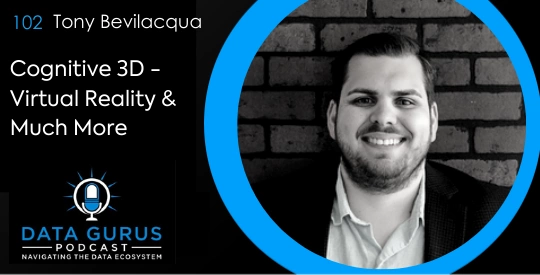Podcast: Play in new window | Download
We’re delighted to have Tony Bevilacqua joining us today! Tony is the CEO and Founder of Cognitive3D, which is based in Vancouver, Canada.
About the previous company that Tony founded
Cognitive3D is the second company that Tony has founded. His previous company was focused on revenue optimization, and it had a very heavy analytics back-end, so they made a lot of decisions which were based on collected data, and the company helped its clients build a better revenue optimization.
With his first company, Tony spent a lot of time working in the game space, and he had some early exposure to the Oculus DK1 and DK2. (The Oculus DK1 and DK2 were the very early development kits that Palmer Luckey created for the Oculus, which is a head-mounted display for virtual reality.)
Founding Cognitive3D
After selling his first company, Tony wanted to spin off and do something in the virtual, augmented, and mixed-reality space, so he ended up founding Cognitive3D late in 2015. From there, he started to construct a new way to visualize spatial outlooks.
The different definitions of virtual reality, and what they mean
- Virtual Reality (VR) is when a user is wearing a head-mounted display that fully encompasses their field of view, and everything they see is computer-generated within the headset.
- Augmented Reality (AR) is a pass-through experience where the user’s world is augmented. However, AR does not necessarily influence or overtake the user’s field of view.
- Mixed Reality (MR) is when the user’s field of view is augmented with additional 3D items, objects, and experiences.
A headset can also be a great vehicle for data collection
Tony points out that if one thinks of the headset as a vehicle for data collection, it can provide a lot of great opportunities to understand both human behavior and human performance.
How Tony went about developing the new, cutting-edge technology
When Tony first encountered the capabilities of the new 3D technology, he saw it as a whole new opportunity to collect insights on how people interact. He understood games and entertainment well, and he was very excited about the potential that virtual reality held. He knew that by using it, he could build a product that could help game developers create even better content, so Cognitive3D started building out a platform for collecting spatial insights.
Taking his new product to the market
When Tony took his company’s new product to market in 2016, he saw that plenty of game developers and entertainment companies were using it. And it was also being used for enterprise, with the two pre-dominant use cases being in consumer research, and training and simulation.
By the beginning of 2017, Tony had fully pivoted his company towards enterprise uses, focusing on consumer research, and training and simulation.
A study done with Kellogg’s
A while ago, Kellogg’s introduced a new product to the market. They wanted to understand the different placements of the product on the shelf and how they could potentially influence users to notice it.
So, Cognitive3D, working alongside with Accenture, Qualcomm, and InContext Solutions, built out a use case and scenario for them in the form of a two-cell study. The first cell was their traditional placements, and the second cell was in an alternate location that was suggested by the Cognitive 3D team, with the additional use of some signage.
In the study, they discovered that although users purchased more products from an eye-level location, they still managed to create enough sales and visibility for the new product, without cannibalizing the rest of the brand category, when they placed the new product at a lower location.
Tony explains that by placing the new product at a lower location, it left the premium display row open to generate sales in the way that it would normally do, and they also had the opportunity to introduce a new product.
Kellogg’s was able to create an eighteen percent lift in their brand sales by using the alternate insights collected from virtual reality and eye-tracking.
A qualitative approach, versus an aggregative approach
When Tony started his company, he began with a qualitative approach, using a 3D visualization platform to visualize how users interacted within the company’s content. This approach is helpful with training and simulation, for things like after-action reviews. It is also helpful with consumer research, for developing hypotheses.
The company also wanted to create more exacting insights from the data they were collecting, so they had to turn to some different methods and tools to reach their desired level of insight. They then introduced some new tools that would allow them to look at every single item within a 3D space, and provide the necessary insights on an aggregate basis. Tony explains that this approach is also somewhat quantitative because it gives an exact result, for a large number of sessions, for a particular item or group of items.
Researching
Many different CPG companies, particularly market research companies who are looking for solutions, and leverage for tool-augmented, and mixed-reality in their researching, have approached Cognitive3D.
They also do a lot of academic research for dozens of institutions across the United States, Canada, and Europe. And they are often approached by brands that are looking to build insights to take to retailers.
Links:
———————————–
Email me your thoughts!
Sima is passionate about data and loves to share, learn, and help others that share that passion. If you love data as much as her, subscribe on iTunes and don’t forget to leave a rating and review!




